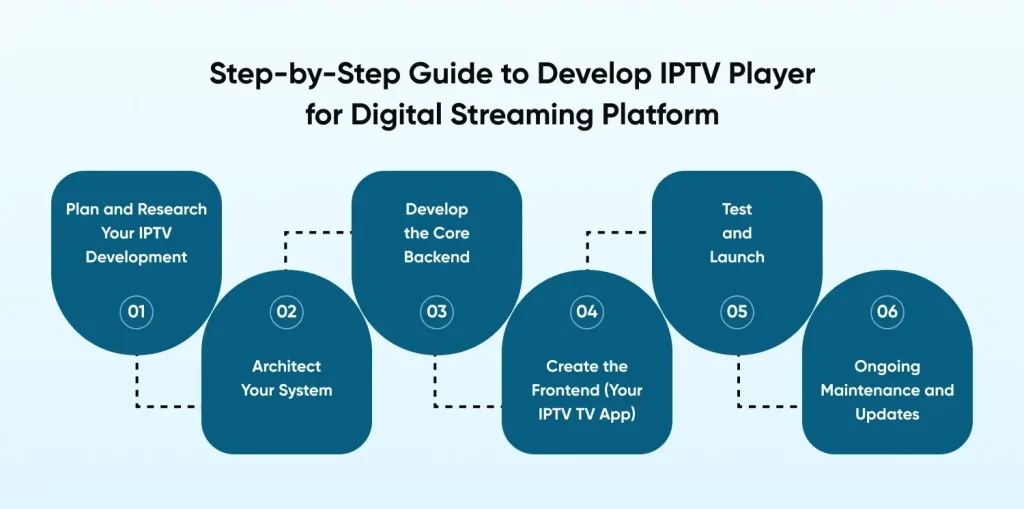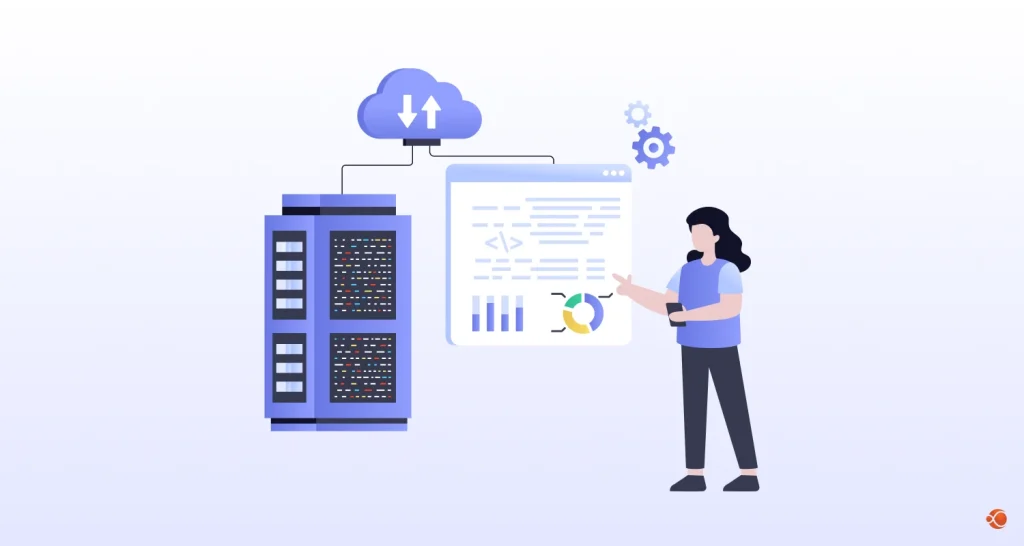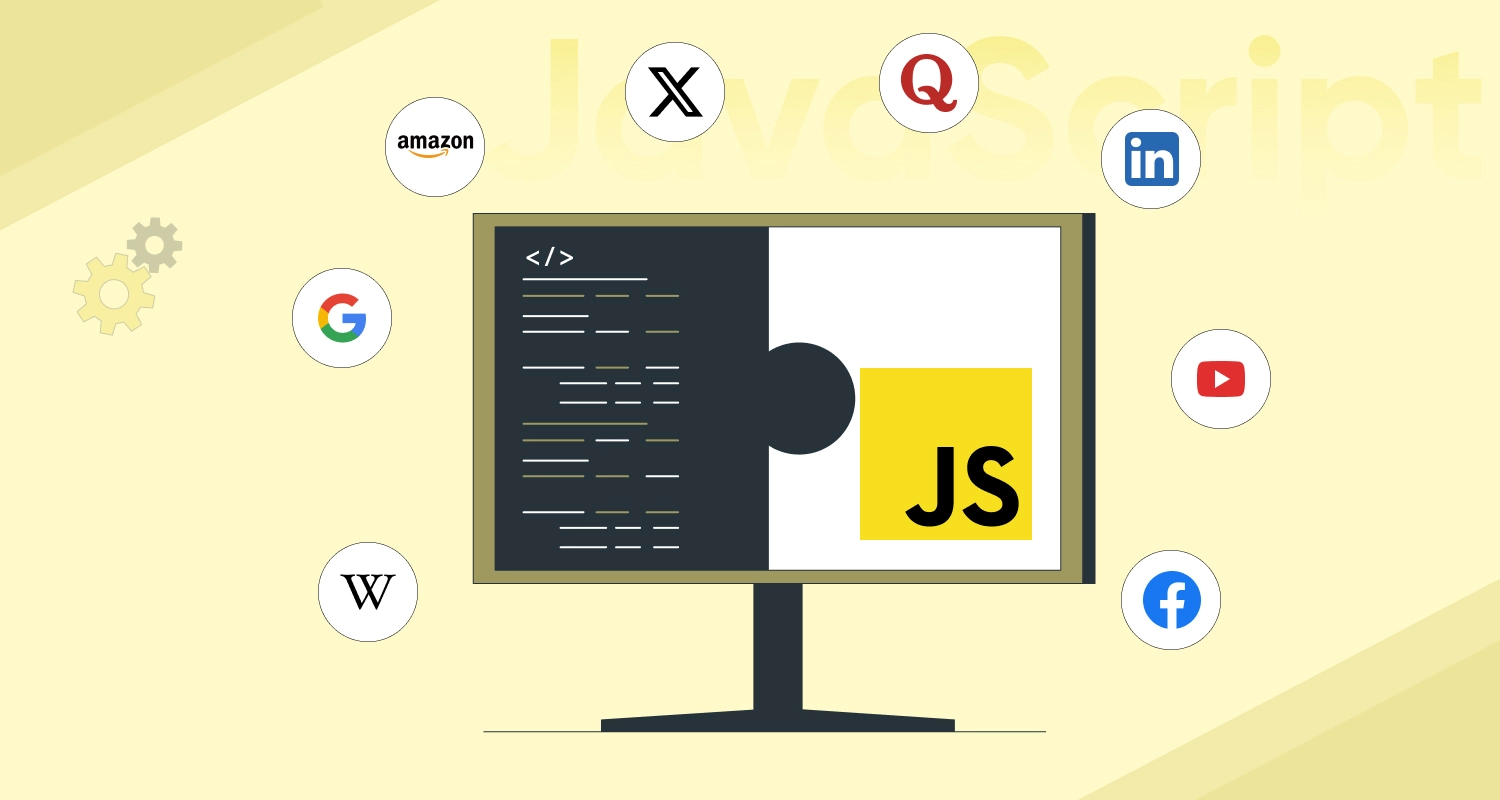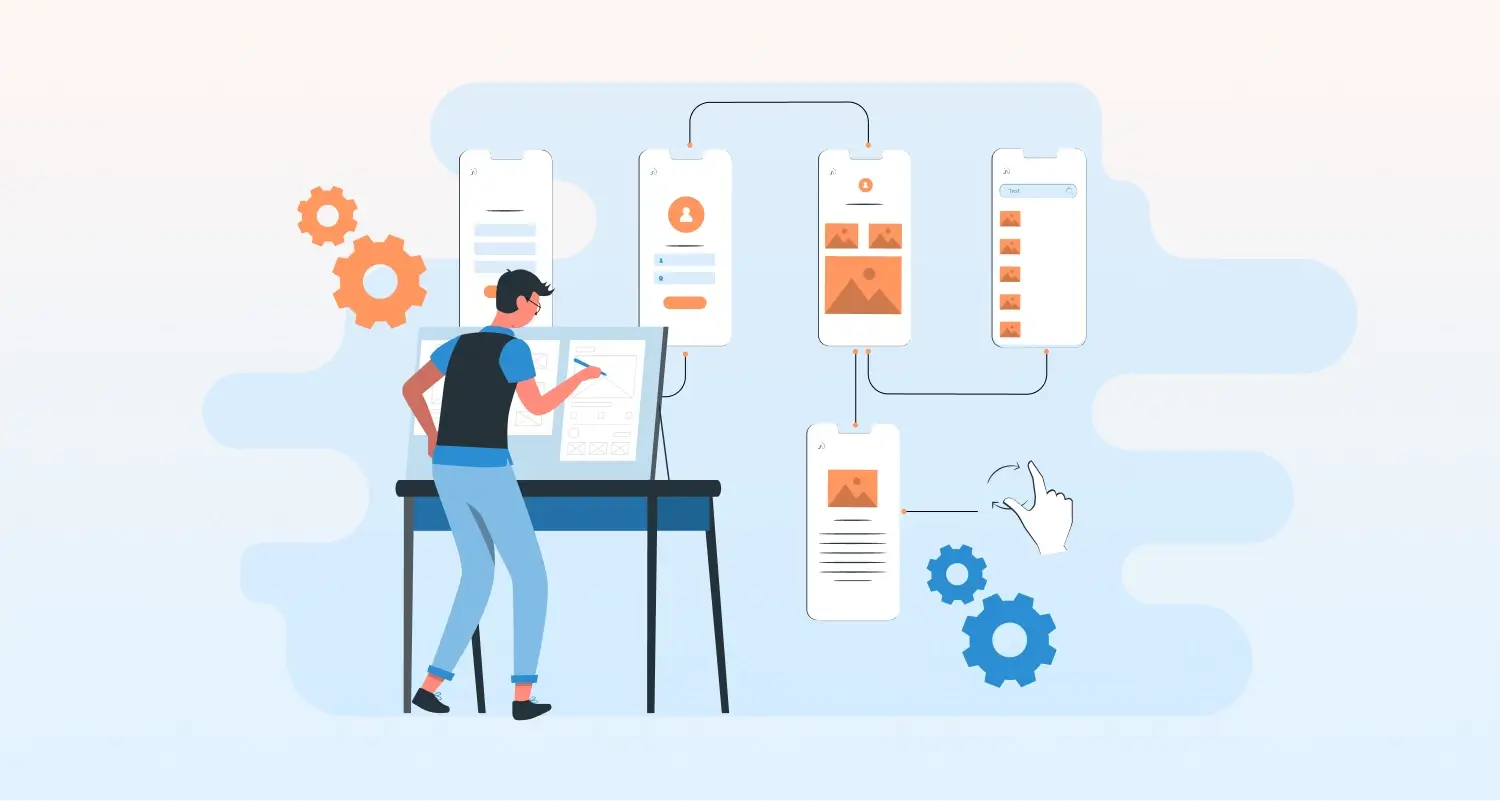Quick Summary: This guide explains how to develop an IPTV player for digital streaming platforms. It covers the key steps like building the backend and frontend, managing content, and delivering smooth video streaming. It also talks about legal content, system setup, and ways to make the platform work for viewers. Following this guide makes it easier to create a legal and easy-to-use IPTV/OTT platform.
With the advancements in media technology and landscape, televisions are slowly taking a backseat and giving way to a more personalized, on-demand world of digital streaming. Powering this shift is this protocol called IPTV that stands short for Internet Protocol Television. As the name suggests, it is a technology that delivers television content over the internet.
The global IPTV market is likely to reach $94 billion by 2025, which shows the growing demand for online streaming platforms. Many companies are now looking to develop IPTV player for digital streaming platforms to provide viewers unparalleled flexibility and control over when, how, and where they watch their preferred content.
This guide is intended to be a definitive resource for anyone looking to build a legal, robust, and scalable IPTV/OTT platform. We will dive deep into all aspects, considerations, and requirements of the process, from legal point of view to technical intricacies of building the platform. So if you are planning to develop an IPTV TV app for a niche audience or build your own IPTV streaming platform from scratch, we will provide you with all the guidance you need to do so.
What is IPTV Development?
IPTV development focuses on creating complete television delivery platforms that operate over internet networks. Unlike traditional video streaming, IPTV solutions provide structured systems that include live broadcast channels, on-demand content libraries and interactive features for improved viewer engagement.
This process includes setting up server infrastructure to store and distribute media effectively, along with middleware solutions that manage subscriptions, user access and service operations. On the user side, applications for smart TVs, mobile phones and streaming devices provide smooth access to content, forming a complete and adaptable digital television ecosystem.
What are the Key Considerations for Your Legal IPTV Platform?
Before any technical work begins, it is important to lay a strong business and legal foundation. This is very important, because you would want your platform to be viable and compliant with all the necessary regulations.
1. Secure Content Licensing and Distribution Rights
Your entire IPTV platform relies on one hero element – the content. You need to make sure all the content you have on your platform is legal, and that you have the proper licenses, distribution rights, and other paperwork for each piece of media you provide to the users.
2. Building an IPTV System: Infrastructure for Scalability
Your platform’s infrastructure needs to be designed and deployed for growth. It needs to be able to handle high-res video streaming for many concurrent users without causing buffering or lag.
For achieving this, you’ll need:
- Robust servers
- High speed internet or network connections
- Well-thought out content delivery strategy
3. Defining a Monetization Strategy
How will your platform generate revenue? This is one of the most important questions you should have when building an IPTV platform. The choice of monetization model will depend on the business decision, which in turn will influence the entire design aspect of your platform.
You can choose from monetization strategies like:
| Model | How It Works | Best For | Revenue Source |
| Subscription Video on Demand (SVOD) | Users are charged recurring fees for unlimited access to the content library. | Building long-term customer base, stable income | Monthly/annual subscription fees |
| Transactional Video on Demand (TVOD) | Users pay per content (rent or buy a single movie/show). | New releases, exclusive or premium content | One-time purchases or rentals |
| Ad-supported Video on Demand (AVOD) | Content is free, revenue comes from ads shown to viewers. | Attracting a large audience quickly | Advertisements (pre-roll, mid-roll, banners) |
| Freemium/Hybrid Model | Combines free, ad-supported access with a paid, ad-free subscription option. | Converting free users into buying subscriptions over time | Combination of subscription fees and advertisements |
The Technical Process: Behind the Scenes of IPTV Platform Development
After we have had a proper business plan in place, we can proceed with the technical intricacies of IPTV development. It is crucial to go through a detailed method of constructing the entertainment software development solution that makes your platform run smoothly.
1. Backend Development (The Server-Side Logic)
The backend is the brain of your operation, managing all data, content, and user interactions.
- Content Management System (CMS): A powerful CMS is essential for ingesting, organizing, and managing your video library. It should allow for easy uploading of video files, adding metadata (descriptions, cast, ratings), and categorizing content.
- Streaming Server & Infrastructure: This is where your video files are stored and served. Specialized streaming servers are used to handle video streams efficiently. The infrastructure must be optimized for fast, reliable delivery to avoid buffering, a common symptom of a poorly built system IPTV.
- User Management & Authentication: A secure system is needed to handle user accounts, authentication, and profiles. This is where you’ll manage subscriptions and payment processing by integrating with a reliable payment gateway.
- Digital Rights Management (DRM) License Server: To protect your licensed content from piracy, you must implement a DRM solution. A DRM license server provides the necessary encryption keys to ensure that only authorized viewers can watch your content.
2. Frontend Development (The IPTV TV App & User Interface)
The frontend is the part of the platform your users interact with, the application itself. It has to be intuitive, visually appealing, and compatible with a wide range of devices.
- Cross-Platform Compatibility: To reach the broadest audience, you must develop IPTV applications for multiple platforms. This includes iOS and Android app for IPTV, web browsers, and smart TVs from manufacturers like Samsung and Vizio IPTV. You should also consider popular streaming devices such as the best IPTV for Firestick, Chromecast, and Roku. A reliable and wanted IP television app is one that is everywhere your audience is.
- Video Player Integration: A fast, high-performance video player is not an option. It should have adaptive bitrate streaming (ABS) capability to adjust automatically as per the internet speed of the user, with the resulting video quality ensuring a seamless, buffer-free viewing experience.
- User Interface (UI) Design: A simple and rational UI is bare essential for user retention. The UI should facilitate easy discovery of new content, search for a specific title, and profile management.
3. Content-Related Services (Essential Software for IPTV)
These services work in the background to ensure your video streaming app development is delivered with optimal quality and speed.
- Video Encoding and Transcoding: Raw video files are large and not optimized for streaming. A transcoder processes these files, creating multiple versions at different resolutions and bitrates. This is a critical step for adaptive streaming.
- Content Delivery Network (CDN): A content delivery network is a global network of servers. It stores copies of your content in distributed data centers that are in close proximity to where your users are, resulting in reduced latency and buffering, and in turn a more consistent and reliable viewing experience.
4. Analytics Dashboard
An all-encompassing analytics dashboard is crucial to know how users are engaging with your platform. It is able to monitor metrics such as overall watch time, most viewed content, user demographics, and where viewers get lost. This information is priceless when it comes to making data-driven decisions about content procurement and improvement of the platform.
Step-by-Step Guide to Develop IPTV Player for Digital Streaming Platform

Here is a practical, step-by-step roadmap for your IPTV development journey. The ultimate goal is to provide an easy path for users to develop IPTV platform for TV or any other device.
1. Plan and Research Your IPTV Development
Define your niche and target audience. Ask questions like, what type of content is going to be available on your platform? or what makes your platform unique?This initial research will guide all subsequent decisions.
2. Architect Your System
Based on your plan, design your system architecture. Hire dedicated developers who can develop IPTV player for digital streaming platform using the right technology stack, including your cloud provider (e.g., AWS, Google Cloud), programming languages, and frameworks. This blueprint will ensure a robust and scalable IPTV system.
3. Develop the Core Backend
Start with the heart of all operations, build a CMS, set up the streaming infrastructure and also have developers work on the user management system that will integrate payment gateways and DRM integration
4. Create the Frontend (Your IPTV TV App)
Once the backend is stable, begin developing the user-facing applications. Always target and optimize the frontend for a single-platform first, generally it’s a good idea to go mobile-first. This way you can expand the design as per the need of other larger screen platforms.
5. Test and Launch
Before going live, put the platform through thorough testing. Check performance, security, and user experience. A small beta launch with real users can provide valuable insights and help fine-tune the app.
6. Ongoing Maintenance and Updates
Congratulations on launching your IPTV platform. If you plan to keep it as a long-term project, you should rely on reliable OTT platform development services that know how to manage and maintain such applications. Make sure they add and introduce new features and content based on feedback from your users.
Different Applications of IPTV Systems
| Application | How It’s Used |
| Home IPTV | Personalized streaming of live and on-demand content for individual households. |
| Hotels & Resorts | In-room entertainment, concierge information, and interactive guest services. |
| Residential Communities | Centralized TV services for multiple homes within an apartment or gated community. |
| Healthcare Facilities | Deliver educational content, patient updates, and entertainment in hospitals. |
| Sports & Entertainment Venues | Live event broadcasting, replays, and exclusive content for spectators. |
| Retail & Shopping Malls | Digital signage with ads, promotions, and wayfinding integrated with IPTV. |
| Transport & Travel | Onboard entertainment for passengers in trains, cruise ships, and buses. |
| Restaurants & Cafes | Display menus, promotions, and entertainment for diners. |
| Correctional Institutions | Educational programs, news, and recreational content for inmates. |
| Government & Education | Stream live events, training materials, and announcements to employees or students. |
Final Words
Building a legal IPTV or OTT platform is a big project. It takes a solid plan, following all legal rules, and technical skill. By focusing on using only legal content, building a strong system that can grow, and making it easy for users to find what they want, you can create a live streaming website. As more people watch digital content, your platform can be an important part of the future of television.
Disclaimer: This guide is intended for educational purposes only. We do not endorse or facilitate piracy or unauthorized streaming. It focuses on developing IPTV/OTT platforms that comply with licensing and intellectual property regulations.
FAQs on How to Develop IPTV Player
What Is the Best Technology Stack for IPTV Player Development?
A well-rounded technology stack for developing an IPTV player typically includes a frontend framework like React or Angular for building the user interface, a backend framework like Node.js with Express for data and streaming logic, and a database like PostgreSQL for user information and content management.
What Does It Require to Make an IPTV Website and Mobile App?
To build an IPTV website and mobile app, you’ll need content, licensing, a CMS, and additional resources such as a content library, streaming infrastructure, IPTV middleware, user interfaces, and DRM.
What Are the Common Challenges in IPTV Player Development?
Developing an IPTV player involves handling multiple streaming protocols, ensuring low latency, and achieving cross-platform compatibility. Content protection through DRM systems and compliance with copyright laws adds complexity. Additionally, designing a user-friendly UI, supporting scalability, and managing adaptive streaming for varied network conditions are significant challenges.







